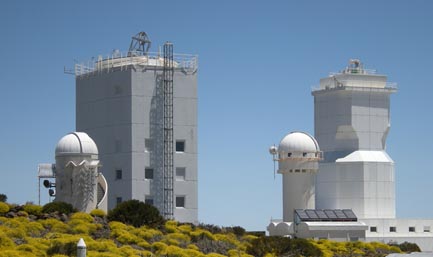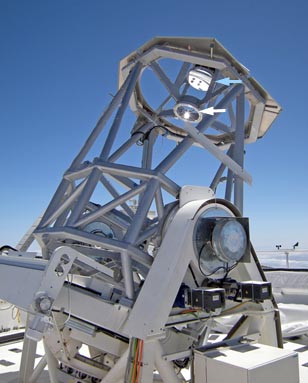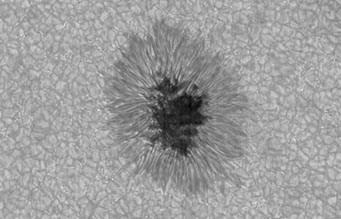With a wide-open design and a clear aperture of 1.5 meters (4.9 feet), the just-completed Gregor telescope will give European astronomers an important new tool for studying the Sun.
For these next few weeks, untold millions of casual skywatchers will turn their eyes sunward (safely, I hope) to witness an annular eclipse and a must-see transit of Venus. Then they'll go back to their everyday routines, not giving the solar surface much additional thought.

Standing side by side at Teide Observatory on Tenerife are the Gregor telescope (atop the building at left) and the Vacuum Tower Telescope, which has a 28-inch (70-cm) primary mirror.
Kiepenheuer Inst. for Solar Physics
But meanwhile, on the island of Tenerife in the Canary Islands, astronomers are putting the final touches on a new telescope designed to watch the Sun all the time — and maybe to gather a little starlight at night as well.
With a clear aperture of 4.9 feet (1.5 m), the Gregor telescope ranks as the largest solar telescope in Europe and the third largest worldwide. The completely open structure allows for free airflow around its optics, which are housed in a clamshell enclosure rather than a traditional dome.

The Gregor telescope has a 1.5-m primary mirror. Its Gregorian optical system has a field stop (white arrow) at prime focus, which blocks stray light from reaching the concave secondary mirror (blue arrow).
Kiepenheuer Inst. for Solar Physics
If you look closely at the image at right you might get a sense that there's more hardware along the light path than normal for a reflector — and you'd be right! That's because it uses Gregorian optics — akin to a traditional Cassegrain, except that the secondary mirror is placed beyond the focus of the f/1.7 primary mirror. This arrangement requires that the secondary be concave, not convex, but more importantly there's a field stop at prime focus that keeps stray light (and heat) from reaching the secondary.
Managing heat will be a major challenge for the Gregor telescope. Its primary, made of low-expansion Zerodur glass, is cooled from the back side to keep its reflective surface from heating up and degrading the mirror's optical performance. The telescope's secondary and tertiary mirrors were fashioned from a special ceramic glass called Cesic, which is silicon carbide reinforced with microscopic carbon fibers. Cesic transfers heat about 100 times faster than other low-expansion glass ceramics.
After bouncing off the Gregor's primary and secondary, sunlight will carom off more than a dozen other mirrors — including an adaptive-optics system — before reaching the telescope's detectors.

On July 15, 2011, the Gregor telescope's broad-band imager recorded this exquisite close-up of a solitary sunspot in hydrogen-alpha light (656 nm). The area shown is about 20,000 miles (32,000 km) across. Click here for a larger version.
Kiepenheuer Inst. for Solar Physics
This circuitous routing can resolve features on the solar disk as small as 45 miles (70 km), and a cluster of imagers, spectrometers, and polarimeters at Gregor's business end will be used to study how magnetic fields evolve in the photosphere and chromosphere, particularly around sunspots and in active regions. The work won't end at sunset, however, as the night shift will use a double spectrograph to study Sun-like stars.
An international consortium, led by the Kiepenheuer Institute for Solar Physics (KIS), Leibniz Institute for Astrophysics, and the Max Planck Institute for Solar-System Research, has been working on the Gregor telescope for a decade. It sits atop a "solar tower" originally used by the 45-cm Gregory Coudé Telescope (GCT), which was removed and relocated in 2002 to make way for its state-of-the-art replacement.
The telescope's formal inauguration is slated for May 21st — hey, maybe you can sneak a peak of the assembled dignitaries using the observatory's webcam. You can also read more about this project at the KIS website.
 7
7
Comments
Jon Hanford
May 17, 2012 at 7:01 pm
Thanks for this story on a new, large-aperature solar telescope Kelly. While checking out the KIS site you linked, it was noted that the primary mirror is actually made of Zerodur instead of Cesic, as mentioned in your article. The page on optical design states "Unfortunately, technological problems prevented the manufacture of the 1.5 m primary from Cesic material. Therefore, a lightweighted main mirror from Zerodur was manufactured. The mass of the mirror is about 215kg. Cooling and mounting of the mirror were adjusted to the new material in order to achieve a comparable performance."Cesic sounds like an interesting material though. Have optics, using Cesic, of around this size (1.5m) been successfully fabricated/employed before?
You must be logged in to post a comment.
Brian Hampton
May 18, 2012 at 2:06 pm
Didn't you notice that Tenerife is not in Europe? It is an African island! There are several Spanish territories in Africa.
Brian J.Hampton
You must be logged in to post a comment.
Kelly Beatty
May 18, 2012 at 4:38 pm
Jon: you're right -- the primary is made of Zerodur, but until yesterday the English version of the project's website said otherwise. the project team didn't realize this until I wrote my story, so they've corrected the website. and I've corrected the story. thanks for the careful reading!
You must be logged in to post a comment.
Bill B
May 19, 2012 at 2:45 am
What happened to the "Image at right".
You must be logged in to post a comment.
Bill B
May 19, 2012 at 3:40 am
Must be a computer glitch. The images came right up after posting my question.
You must be logged in to post a comment.
Bruce
May 19, 2012 at 6:53 am
This is good news. Better tools to study the sun are definately called for, in veiw of what the Kepler Mission is revealing about superflaring sun-like stars. Finding out what causes sunspots and the flares & CMEs they eject is at least as important as the hunt for earth crossing asteroids.
You must be logged in to post a comment.
Jon Hanford
May 19, 2012 at 7:03 pm
Speaking of new solar telescopes, I'm keenly looking forward to completion of the 4-meter Advanced Technology Solar Telescope currently under construction atop the Haleakala Volcano in Hawaii: http://atst.nso.edu/
First light is expected in 2019.
You must be logged in to post a comment.
You must be logged in to post a comment.